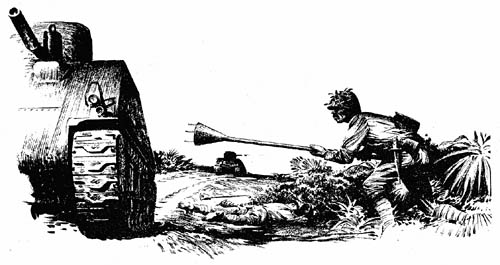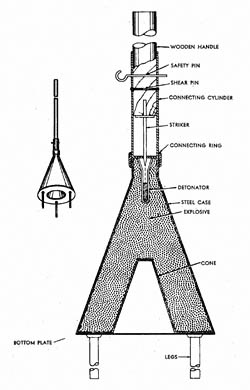
 This suicide mine, an antitank device used by Japanese Close-quarter Combat Units, consists of a conical-shaped hollow charge encased in a steel container, and a wooden handle. Three legs equally spaced around the base of the charge provide proper stand-off distance. A well in the apex of the charge contains the detonator.
This suicide mine, an antitank device used by Japanese Close-quarter Combat Units, consists of a conical-shaped hollow charge encased in a steel container, and a wooden handle. Three legs equally spaced around the base of the charge provide proper stand-off distance. A well in the apex of the charge contains the detonator.
The firing mechanism, quite simple in construction, consisting of a needle type striker, a shear pin, and a safety pin, is housed in a metal sleeve. This sleeve, which holds the mine” and the handle 2.4 inches apart, slips over the end of the handle and is held in place by the shear pin and safety pin; it is attached to the body of the mine by a threaded connecting ring.
To operate the mine, the soldier must first remove the safety pin, and then, using bayonet tactics, lunge forward striking the mine squarely against the tank. When the legs of the mine strike the target, the handle is driven forward breaking the shear pin, and the striker is driven into the detonator, initiating explosion of the mine.
Reports indicate that when head-on contact is made, the mine will penetrate 6 inches of steel plate; with contact at a 60° angle, steel plates of approximately 4 inches can be penetrated.
SPECIFICATIONS
| Length of mine body (approx.) | 12 ins. | |
| Diameter of base of body (approx.) | 8 ins. | |
| Length of handle | 59 ins. | |
| Diameter of handle | 1 1/4 ins. | |
| Weight of explosive charge | 6 1/2 lbs. | |
| Length of legs | 5 1/4 ins. | |
| Weight of mine (total) | 14.3 lbs. |
Japanese: p. 308.3 (May 1, 1945)